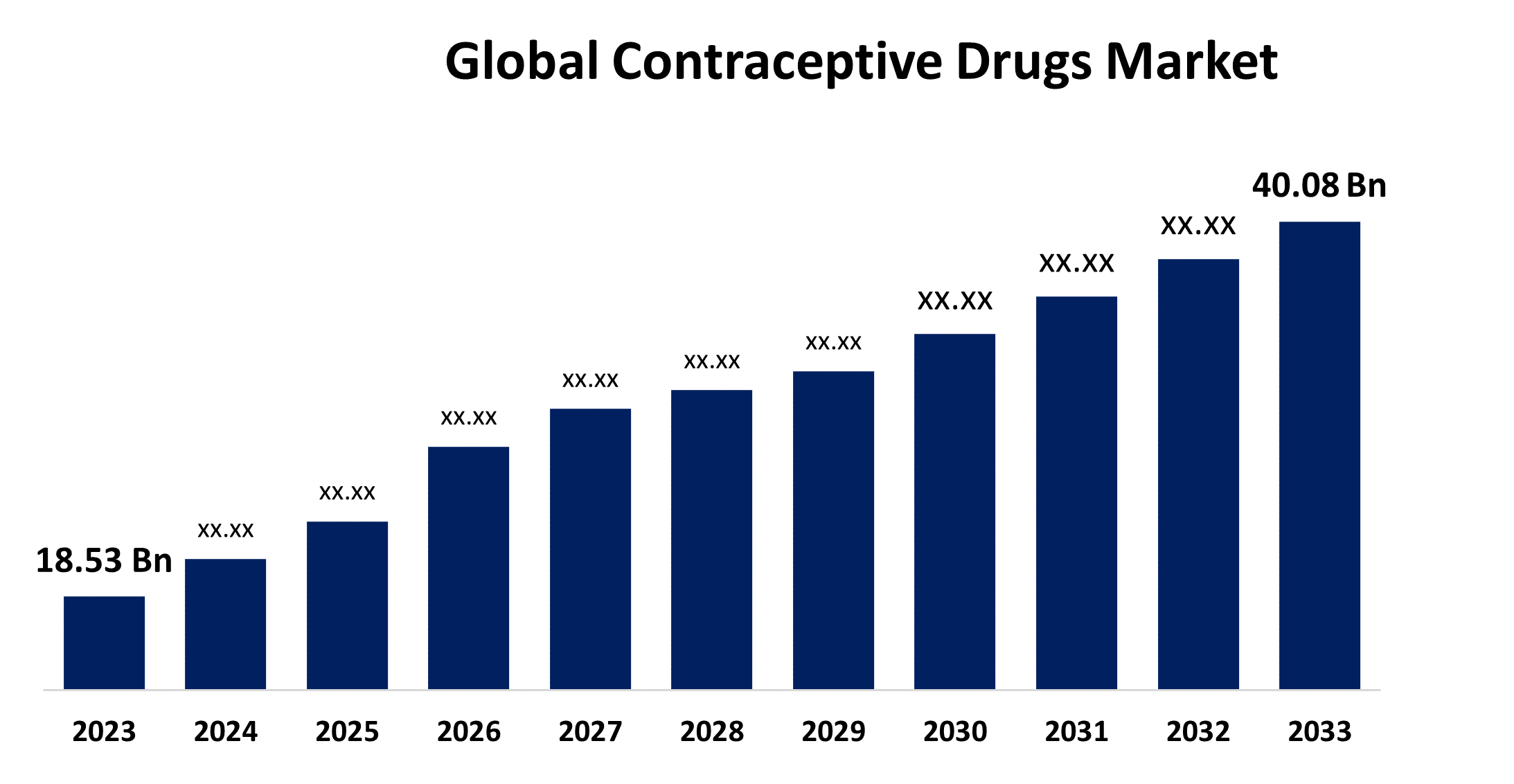Global Contraceptive Drugs Market Size, Share, and COVID-19 Impact Analysis, By Product (Oral (Combined Contraceptives and Progestin-only Pills), Injectable, and Patches), By Distribution channels (Hospital Pharmacy, Retail Pharmacy, Clinics, Online Channel, Public Channel and NGOs, and Others), and By Region (North America, Europe, Asia-Pacific, Latin America, Middle East, and Africa), Analysis and Forecast 2023 - 2033
Industry: HealthcareGlobal Contraceptive Drugs Market Insights Forecasts to 2033
- The Global Contraceptive Drugs Market Size was Valued at USD 18.53 Billion in 2023
- The Market Size is Growing at a CAGR of 8.02% from 2023 to 2033
- The Worldwide Contraceptive Drugs Market Size is Expected to Reach USD 40.08 Billion by 2033
- Asia Pacific is Expected to Grow the fastest during the forecast period.

Get more details on this report -
The Contraceptive Drugs Market Size is Anticipated to Exceed USD 40.08 Billion by 2033, Growing at a CAGR of 8.02% from 2023 to 2033.
Market Overview
The primary objective of contraception is to reduce the risk of sexually transmitted infections (STDs), prevent unintended pregnancies, and regulate the birth rate. After puberty and before menopause, or between the ages of 15 and 44, these medications are used by fertile women. A variety of end users utilize contraceptive medications for birth control and family planning, as well as to avoid pregnancy and STIs. Contraceptive medications are one kind of birth control and are used to prevent pregnancy. This incremental increase rate can be explained by several factors, including the rising incidence of unintended pregnancies, STDs, technological developments in devices, and women's growing awareness of sexual health. It is projected that favorable government initiatives in industrialized nations to reduce unintended pregnancies will have a major beneficial influence on market expansion. The increased use of contraception has decreased the chance of STDs and improved health outcomes, such as maternal and infant mortality. Furthermore, it is anticipated that in the upcoming years, market expansion will be fueled by a rise in the number of gynecologists who support these contraceptive methods for birth control. The growing usage of safe and dependable oral tablets, growing awareness of contemporary contraceptives, and health issues related to teen pregnancies are all taken into account in the market estimates for contraceptives.
Report Coverage
This research report categorizes the market for the contraceptive drugs market based on various segments and regions forecasts revenue growth and analyzes trends in each submarket. The report analyses the key growth drivers, opportunities, and challenges influencing the contraceptive drugs market. Recent market developments and competitive strategies such as expansion, product launch, and development, partnership, merger, and acquisition have been included to draw the competitive landscape in the market. The report strategically identifies and profiles the key market players and analyses their core competencies in each sub-segment of the contraceptive drugs market.
Global Contraceptive Drugs Market Report Coverage
| Report Coverage | Details |
|---|---|
| Base Year: | 2023 |
| Market Size in 2023: | USD 18.53 Billion |
| Forecast Period: | 2023-2033 |
| Forecast Period CAGR 2023-2033 : | 8.02% |
| 2033 Value Projection: | USD 40.08 Billion |
| Historical Data for: | 2019-2022 |
| No. of Pages: | 207 |
| Tables, Charts & Figures: | 110 |
| Segments covered: | By Product, By Distribution channels, By Region |
| Companies covered:: | Allergan, Bayer AG, Pfizer Inc, Piramal Enterprises Ltd., Johnson and Johnson Private Limited, Mylan N.V., Teva Pharmaceutical Industries Ltd., Merck and Co., Inc., Lupin Limited, Cipla Ltd., Famy Care Ltd., Mithra Pharmaceuticals, Abbvie, Janssen Pharmaceuticals, Inc., and Others Key Vendors. |
| Pitfalls & Challenges: | COVID-19 Empact, Challenges, Future, Growth, & Analysis |
Get more details on this report -
Driving Factors
The prevalence of contraceptives is continuously increasing, which is driving the expansion of the contraceptive market as a whole. As women's empowerment and understanding of sexual health issues increase, more people are looking for effective, reversible prevention against unwanted pregnancies. Through numerous campaigns and public awareness programs, non-profit organizations and regional and national healthcare institutions are placing an increasing focus on enhancing women's sexual and reproductive wellness. These for-profit and nonprofit groups encourage the public to use contraceptive methods and raise knowledge of the different options available, particularly the rising popularity of these medications. The contraceptive market is expanding due in large part to the increasing number of government efforts that support family planning and contraceptive availability. Numerous governments worldwide acknowledge that enhancing the availability of contraception allows individuals to make free and responsible decisions regarding the quantity and spacing of their children.
Restraining Factors
Progesterone and estrogen, two synthetic hormones present in contraceptive pills, are known to have several harmful effects on women. Nausea, headaches, breast tenderness, mood swings, weight gain, and in certain situations decreased libido are typical side effects. Long-term use can also cause issues for some women, such as blood clots, high blood pressure, and cervical cancer.
Market Segmentation
The contraceptive drugs market share is classified into product, and distribution channels.
- The oral (combined contraceptives and progestin-only pills) segment dominates the market with the highest market share through the forecast period.
Based on the product, the contraceptive drugs market is categorized into oral (combined contraceptives and progestin-only pills), injectable, and patches. Among these, the oral (combined contraceptives and progestin-only pills) segment dominates the market with the highest market share through the forecast period. Demand and acceptance for oral contraceptives are steadily rising, especially in developing nations. This is because oral contraceptive pills have therapeutic advantages over other conventional methods and are less expensive than other modern methods of contraception.
- The retail pharmacy segment accounted for the largest revenue share through the forecast period.
Based on the end-user, the contraceptive drugs market is categorized into hospital pharmacy, retail pharmacy, clinics, online channel, public channel and NGOs, and others. Among these, the retail pharmacy segment accounted for the largest revenue share through the forecast period. This corresponds to both the general public's growing desire for contraceptive tablets and their growing knowledge of the range of contraceptive medication options available. In many countries, birth control tablets are available over-the-counter. Because of this, consumers are buying birth control tablets from retail pharmacies more and more frequently. Favorable regulations have also played a role in the development of the market.
Regional Segment Analysis of the Contraceptive Drugs Market
- North America (U.S., Canada, Mexico)
- Europe (Germany, France, U.K., Italy, Spain, Rest of Europe)
- Asia-Pacific (China, Japan, India, Rest of APAC)
- South America (Brazil and the Rest of South America)
- The Middle East and Africa (UAE, South Africa, Rest of MEA)
North America is anticipated to hold the largest share of the contraceptive drugs market over the predicted timeframe.

Get more details on this report -
North America is projected to hold the largest share of the contraceptive drugs market over the forecast period. Driven by elements including modern healthcare infrastructure, supportive government initiatives, and high awareness levels. Contraceptives are widely accessible in nations like the United States and Canada, where a variety of alternatives are sold over the counter or through medical professionals. Comprehensive sexual education initiatives in community and educational settings also help people become more aware of and use contraceptives. Leading pharmaceutical firms are present in North America, which encourages market expansion since they are constantly innovating and creating new contraceptive products that meet changing consumer preferences and demands.
Asia Pacific is expected to grow at the fastest CAGR growth in the contraceptive drugs market during the forecast period. The demand for contraceptive pills is raising due to increased government attempts to increase access to these medications and increased public knowledge about pills. Furthermore, the market for birth control pills and other forms of contraception is being impacted by the increased focus on family planning due to the rise in unplanned pregnancies.
Competitive Analysis:
The report offers the appropriate analysis of the key organizations/companies involved within the contraceptive drugs market along with a comparative evaluation primarily based on their product offering, business overviews, geographic presence, enterprise strategies, segment market share, and SWOT analysis. The report also provides an elaborative analysis focusing on the current news and developments of the companies, which includes product development, innovations, joint ventures, partnerships, mergers & acquisitions, strategic alliances, and others. This allows for the evaluation of the overall competition within the market.
List of Key Companies
- Allergan
- Bayer AG
- Pfizer Inc
- Piramal Enterprises Ltd.
- Johnson and Johnson Private Limited
- Mylan N.V.
- Teva Pharmaceutical Industries Ltd.
- Merck and Co., Inc.
- Lupin Limited
- Cipla Ltd.
- Famy Care Ltd.
- Mithra Pharmaceuticals
- Abbvie
- Janssen Pharmaceuticals, Inc.
- Others
Key Target Audience
- Market Players
- Investors
- End-users
- Government Authorities
- Consulting And Research Firm
- Venture capitalists
- Value-Added Resellers (VARs)
Recent Developments
- In August 2023, The FDA in the United States approved Lupin's Turqoz (Norgestrel and Ethinyl Estradiol Tablets USP) product. This is a generic version of the Lo/Ovral-28 tablets made by Wyeth Pharmaceuticals LLC.
- In June 2023, The Biden-Harris administration and Upstream introduced a public-private cooperation aimed at addressing the growing health inequities in the US and expanding access to contraception.
Market Segment
This study forecasts revenue at global, regional, and country levels from 2020 to 2033. Spherical Insights has segmented the contraceptive drugs market based on the below-mentioned segments:
Global Contraceptive Drugs Market, By Product
- Oral
- Combined Contraceptives
- Progestin-Only Pills
- Injectable
- Patches
Global Contraceptive Drugs Market, By Distribution Channel
- Hospital Pharmacy
- Retail Pharmacy
- Clinics
- Online Channels
- Public Channels & NGOs
- Others
Global Contraceptive Drugs Market, By Regional Analysis
- North America
- US
- Canada
- Mexico
- Europe
- Germany
- UK
- France
- Italy
- Spain
- Russia
- Rest of Europe
- Asia Pacific
- China
- Japan
- India
- South Korea
- Australia
- Rest of Asia Pacific
- South America
- Brazil
- Argentina
- Rest of South America
- Middle East & Africa
- UAE
- Saudi Arabia
- Qatar
- South Africa
- Rest of the Middle East & Africa
Frequently Asked Questions (FAQ)
-
1.What is the CAGR of the global contraceptive drugs market over the forecast period?The global contraceptive drugs market is to expand at 8.02% during the forecast period.
-
2.Which region is expected to hold the highest share in the global contraceptive drugs market?The North America region is expected to hold the largest share of the global contraceptive drugs market.
-
3.Who are the top key players in the contraceptive drugs market?The key players in the global contraceptive drugs market are Allergan, Bayer AG, Pfizer Inc, Piramal Enterprises Ltd.,Johnson and Johnson Private Limited, Mylan N.V.,Teva Pharmaceutical Industries Ltd., Merck and Co., Inc., Lupin Limited, Cipla Ltd., Famy Care Ltd.,Mithra Pharmaceuticals, Abbvie, Janssen Pharmaceuticals, Inc.
Need help to buy this report?